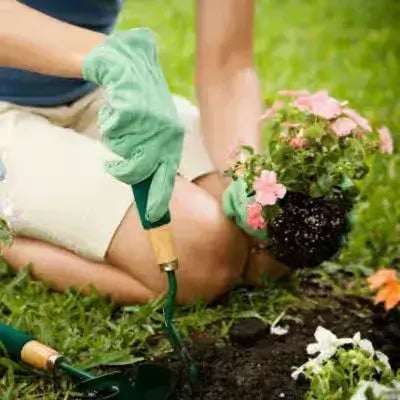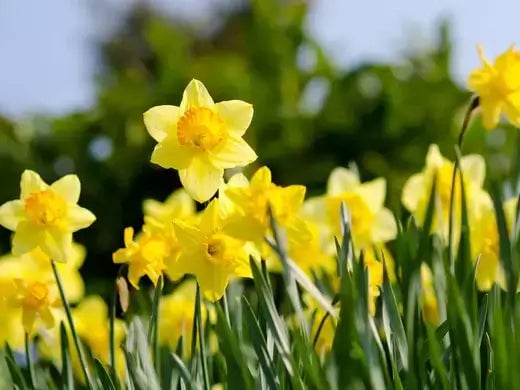The Effortless Elegance of Daffodil Bulbs: A Guide to Planting and Cultivating
Gardening enthusiasts and novices are often captivated by the charm and beauty of daffodil bulbs. These vibrant and iconic springtime flowers have long been favored for their effortless cultivation and stunning visual impact.
Whether you're an experienced gardener seeking a touch of elegance or a beginner looking for a simple yet rewarding endeavor, daffodil bulbs are an ideal choice. In this guide, we'll explore why daffodil bulbs are among the easiest plants in your garden and give step-by-step instructions to ensure successful cultivation.
The Allure of Daffodil Bulbs
Daffodils, scientifically known as Narcissus, are renowned for their unmistakable trumpet-shaped flowers and distinctive color variations. Their bright and cheerful hues of yellow, white, and orange evoke feelings of joy and anticipation as they herald the arrival of spring. One of the most appealing aspects of daffodil bulbs is their ability to thrive with minimal effort, making them a perfect choice for both seasoned gardeners and beginners.
Ease of Planting
Low Maintenance Requirements: Daffodil bulbs do not require constant attention, making them an excellent choice for those with limited gardening experience.
Naturalizing Capability: Daffodils can naturalize, meaning they can multiply and spread over time without much intervention. Once planted, they can continue to bloom and thrive for years with little to no additional effort.
Adaptability: These bulbs are well-suited to various soil types and climatic conditions, making them versatile additions to gardens in multiple regions. They can flourish in both full sun and partial shade, providing flexibility in planting locations.
Planting Daffodil Bulbs: Step-by-Step Guide
To maximize the success of your daffodil bulb planting endeavor, follow these simple steps:
Selecting Bulbs: Choose high-quality daffodil bulbs from reputable nurseries or garden centers. Look for firm, plump bulbs without signs of mold or damage.
Choosing a Location: Opt for a well-draining area with ample sunlight exposure. Daffodils generally prefer soil that is slightly acidic to neutral in pH.
Preparing the Soil: Loosen the soil using a garden fork or tiller. Mix in some organic compost to enhance soil structure and fertility.
Planting Depth: Dig holes roughly three times the bulb's height. It equates to a depth of about 6-8 inches (15-20 cm), while smaller bulbs require a depth of 4-6 inches (10-15 cm).
Spacing: Place bulbs at a distance of 4-6 inches (10-15 cm) apart to allow for proper growth and airflow.
Positioning: Plant the bulbs with the pointed end facing upwards and the flat or slightly concave end facing downwards. It ensures the proper emergence of the shoots.
Covering and Watering: Gently backfill the holes with soil, pressing it down slightly to eliminate air pockets. Water the newly planted bulbs thoroughly to encourage root establishment.
Mulching: Apply a layer of mulch to conserve moisture and suppress weed growth. It also helps to regulate soil temperature.
Post-Planting Care: After the initial watering, maintain a consistent moisture level in the soil. However, avoid overwatering, as daffodils dislike waterlogged conditions.
Fertilization: While daffodils are relatively low-maintenance, applying a balanced fertilizer in early spring and after flowering can promote healthy growth and future blooms.
Caring for Daffodils Pruning: Remove the spent blooms to prevent seed formation once daffodil flowers fade. Allow the foliage to die back as it helps replenish the bulb for the following year's growth.
Dividing Bulbs: Over time, daffodil bulbs can become crowded and produce fewer blooms. To rejuvenate the planting, lift and separate the bulbs every 3-5 years during the dormant period (late summer to early fall).
Pest and Disease Control: Daffodils generally resist most pests and diseases. However, watch out for signs of bulb-destroying pests like squirrels or voles, and take appropriate measures if needed.
Conclusion
In the gardening world, few plants offer the combination of beauty, ease of cultivation, and longevity that daffodil bulbs do. These charming flowers require minimal effort to plant and care for, making them an excellent choice for beginners and experienced gardeners.
With their ability to naturalize and thrive in diverse conditions, daffodils give any garden a touch of elegance and color. By following the straightforward planting and care instructions outlined in this guide, you can effortlessly cultivate a breathtaking display of daffodil blooms that will brighten your landscape year after year.
With their undeniable allure, Daffodil bulbs hold a timeless fascination for seasoned gardeners and novices alike. These remarkable botanical gems, belonging to the Narcissus genus, possess an innate charm that captivates hearts and landscapes alike. Their appeal is multifaceted, stemming from their vibrant hues, delicate fragrance, and the promise of spring they carry.
The daffodil's most striking feature is its blossoms, which come in various colors ranging from pristine whites and sunny yellows to intricate blends of creams and pinks. This wide array of shades ensures a daffodil suits every taste and garden palette. Their petals gently unfurl, unveiling detailed cups or trumpets at their centers, adding an artistic touch to nature's canvas.
Daffodils possess a subtle yet delightful fragrance that signals the arrival of spring. This fragrance, often associated with renewal and optimism, enchants outdoor spaces, inviting us to appreciate the changing seasons and the beauty they bring. The scent of daffodils is a nostalgic reminder of past springs and a beacon of hope for the seasons yet to come.
The allure of daffodil bulbs also lies in their symbolism. These flowers symbolize new beginnings and personal growth, making them popular for various occasions, from weddings to celebrating life achievements. Their appearance each year after a long winter hibernation evokes a sense of rejuvenation and resilience, reminding us that beauty can emerge even after the darkest times.
Furthermore, daffodil bulbs are relatively easy to cultivate their hardiness and adaptability allow them to flourish in various environments, whether in flower beds, containers, or naturalized meadows.
In essence, the allure of daffodil bulbs extends beyond their visual appeal. It encompasses the emotions they evoke, the hope they inspire, and the ease with which they can be integrated into diverse landscapes. As we plant these bulbs and await their splendid blooms, we are reminded of the cyclical nature of life, the passage of time, and the enduring beauty of the natural world.
Read more

Wednesday, September 21Growing crabapple trees in the home garden can be a great option. They are lovely to look at, and they enhance the look of your garden, attracting many birds, squirrels, bees...

Whether cultivating a small balcony garden or tending to an extensive backyard oasis, individuals who embark on this journey will indeed find themselves enriched by the experience in ways that exte...


